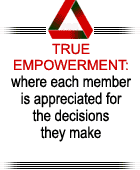Successful projects have a lot in common: they are completed on time, on budget, and achieve the results that everyone expected. Exceptionally well-managed projects have one more dimension--top-notch team performance.
A project team that starts with the same understanding of their organizational mission, their project's particular purpose, and their individual strengths performs more effectively, yields better results, and imparts an enduring legacy of experience and skill to the corporation. This is the kind of team you want; the kind of team PRSL can help you develop and retain through our Top Team Performance Model.
Projects succeed when:
- the individual experience of team members is matched to appropriate roles and realistic expectations (Accountabilities);
- they agree on the approach that will solve the problem (Best Practices);
- their experience includes knowledge of the business solution (Application Context); and
- they have been given an environment that supports communications and the sharing of ideas (Project Environment).
The following model, based on more than 30 years of experience with multi-disciplinary teams in large and small projects, is the key to securing top team performance.
Place your mouse over each of the ovals in order to display further details within this model.
Your project team must function in a "Networked Environment" that is free of external interference and characterized by:
- Virtual teams, which are able to function independent of location and time zones
- Coordination focus, where each member knows what is expected at all times
- Authority of knowledge, when team members with the appropriate knowledge and experience are empowered and made accountable for results.
- Simultaneous activities, when team members can operate independent from each other but remain coordinated
- Horizontal communication, when every member is considered an equal and communications and information is facilitated without fear or concern
- True empowerment, when each member is appreciated for the decisions they make and not penalized for inappropriate ones
- Flexible work environment, when each member can operate and work at their own pace within the plan
- Team achievement, when there is no heroics and all contribute and the team is rewarded for their shared accomplishments
- Trust and integrity, so all communicate freely and knowledgeably.
Finally, each member must be able to explain how to complete each and every task in the project and define the conditions for its acceptance and measurement.









